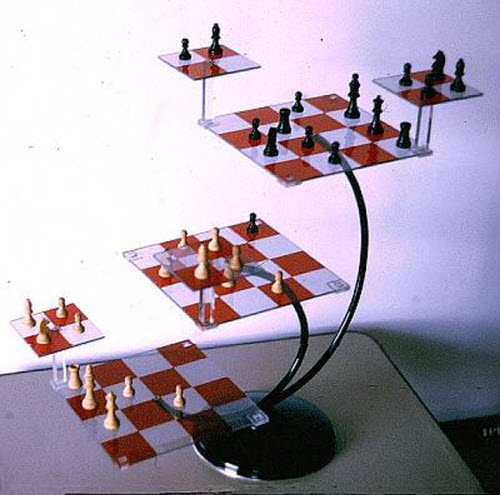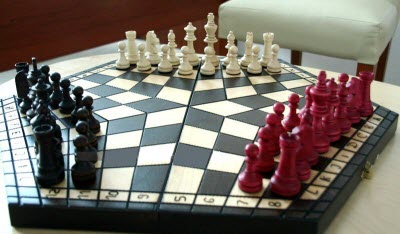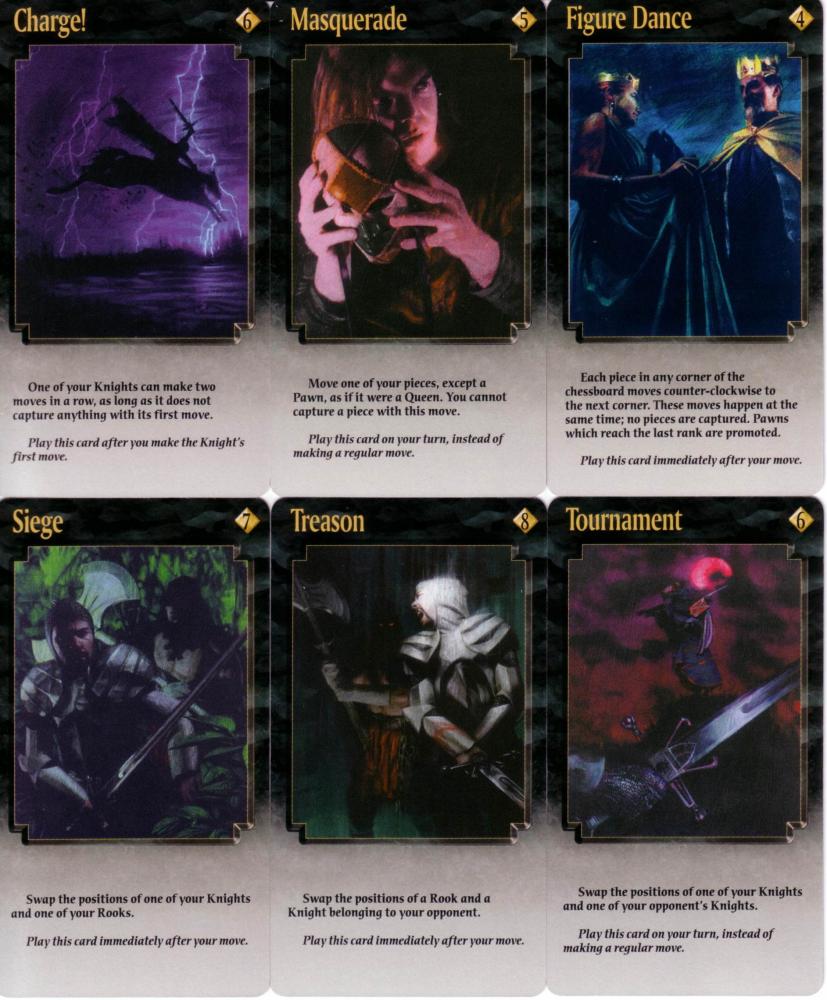Chess has been one of the foremost games of strategy and skill in the Western world for centuries. However, chess is partially defined by the fact that the stronger player will almost always win. There is no handicap built in, and there’s no application of that great leveler of the playing field that is random chance.
While this can be seen as a sign of the strategic purity of the game – an unsullied mental contest – it leads to a lot of people who lose interest in playing. It is the game of “intellectuals”, almost more of a symbol of formidable mental prowess than anything else. Think of how chess has been portrayed in popular media of the last forty years. It is the domain of old men in the city park (with possibly nothing better to do) and eccentric geniuses who play to drive home the point of their abstract intelligence.
So, Chess has an image. Mastering Chess takes the dedication of years of work. But finding new ways to have fun with it…that’s what gamers do best. When most people think of Chess Variants, they think of re-skins. Versions like “Simpsons Chess”, “Halo Chess”, “Star Trek Chess” are merely classic Chess boards with cosmetic changes of the pieces to look like popular characters from whichever franchise the game company was pushing. Many don’t realize that the depth of Variant possibilities goes so much deeper. From tweaking the game to redesigning the board itself, there have been several Variants made over the years that have gained their own, often almost underground, following.
Tri-Dimensional Chess
Perhaps the best known, or at least the most recognizable, is Tri-Dimensional Chess. Sometimes called 3D Chess or Star Trek Chess, it was created as a prop for the Original Series of Star Trek. The producers needed a game for the crew to play in the recreational areas of the ship that the audience would recognize. Taking parts from 3D Tic-Tac-Toe and 3D Checkers sets available at the time (though not so easy to find anymore), they successfully created a futuristic “adaptation” of the game.
While looking much more complex (by design), there are actually very few changes to the movement rules themselves. The board itself is clearly the biggest difference. There are three partially overlapping 4×4 main boards, with four moveable 2×2 side boards. As intimidating as keeping track of pieces moving back and forth along different elevations may seem, it is actually quite simple if you adopt a bird’s eye view. When viewed from above, the board “flattens” into a rectangular board with small offshoots at the end.
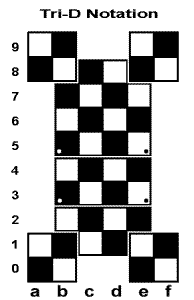
It’s futuristic magic!
All pieces retain their normal movement rules, with the following additions: When moving laterally, a piece may move to a matching square immediately above or below the ending square. A Rook in the corner of a main board could move 3 spaces and end on the same board, or the one above/ below. A piece may only move between levels as part of a lateral move, and only once per move. (Translation: if a Pawn is in your Bishop’s way, you cannot “jump” it by moving up or down a level and then returning to the original level in the same move.)
Also, if a player has a pawn on one of the side boards, and it is the only piece there, as an action that player may move that board to an adjacent empty corner (adjacent may mean diagonally). This is the part of the Variant that requires the most thought, because by doing so you are changing the shape and alignment of the board, so you must make sure it is to your benefit and not your opponent’s.
Unfortunately, finding a Tri-Dimensional Chess set to play isn’t as easy as one might hope. Paramount never seriously tried to market the game to fans, an egregious oversight that would’ve been an instant hit with their audience. There have been five television series and eleven movies in this franchise, so you certainly have a marketable demographic. You can make regular Chess sets with Star Trek ships and characters as the pieces, but not a unique and utterly marketable piece of memorabilia? Needless to say, they dropped the ball. The only set available for purchase is one released by the Franklin Mint, a smaller replica plated in gold and silver. It’s also ridiculously expensive. The only other alternative is to build your own or find a hobby craftsman to make one for you. Making a properly aligned frame/ stand is the biggest challenge, as the boards themselves are just clear grids. If you or someone you know is skilled with metal, fine, but this wood design might be more manageable:
The game is a fun Variant due to the introduction of a third dimension of strategy. It’s a geeky shout-out that most Star Trek fans will immediately recognize and appreciate, whether to play or as a show piece. It looks much more complicated than the classic iteration, and it’s that more visually striking. If you’re looking to impress people with a statement about your intellectual prowess, this may be just the prop you’re looking for.
Be prepared, however, if someone who actually plays Chess wants to try it out.
Three-D Chess
As impacting as Star Trek’s new variation was, the idea of playing Chess in three dimensions was not an original one. There have been similar variations going as far back as the 1850s. These games took a more straightforward approach, with additional boards above and below, making several full layers to play on. Lionel Kieseritzky created what he called Cubic Chess in 1851. Since Chess boards are 8×8 squares, he proposed a cubed board of 8x8x8. Yep, that’s 8 boards stacked one on top of the other. While an interesting concept, moving pieces between that many levels proved difficult to reach, let alone conceptualize.
In 1907, Dr. Ferdinand Maack simplified Cubic Chess when he made Raumschach, a 5x5x5 Chess grid. There were a few changes made to the pieces, with each side getting two additional Pawns and a unique piece called the Unicorn, designed specifically for three dimensional movement. It enjoyed moderate success for 20 to 30 years but eventually fell to the same criticisms Cubic Chess experienced. Five boards, while offering a wealth of strategic options, was not something the general public embraced with a passion.
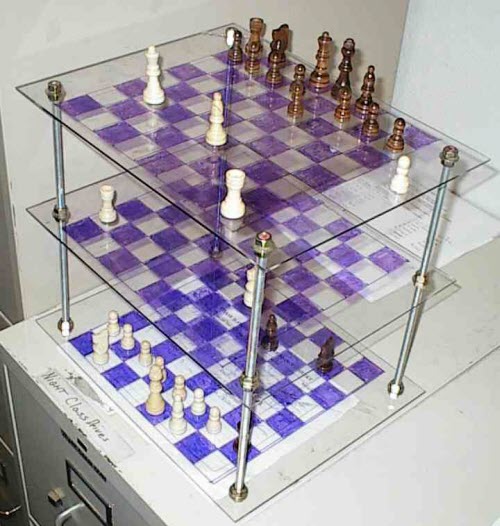 Today, what is generally marketed as “3D” chess is called Millennium or Stratos Chess and is played on three full-sized boards (8x8x3). While this abandons the cubic nature of its predecessors, keeping track of a top, middle and bottom board has been found to be far easier. Movement of the pieces remains similar to that seen in Tri-Dimensional Chess. The biggest difference is that rather having a partial overlap and additional side boards, there is total overlap instead.
Today, what is generally marketed as “3D” chess is called Millennium or Stratos Chess and is played on three full-sized boards (8x8x3). While this abandons the cubic nature of its predecessors, keeping track of a top, middle and bottom board has been found to be far easier. Movement of the pieces remains similar to that seen in Tri-Dimensional Chess. The biggest difference is that rather having a partial overlap and additional side boards, there is total overlap instead.
All of these three-dimensional variations amplify the already heavily strategic gameplay Chess is known for, without doing much to increase it’s audience. If you enjoy playing Chess, you know how difficult it can be to find opponents outside of your regular gaming circle. Chess is known for emphasizing the intellectual component rather than the enjoyment of the game experience (although yes, the two can go hand in hand). Star Trek’s Tri-Dimensional Chess has a pop culture lure to it, elevating it slightly closer to acceptance than the other contenders. It will help if you already have an opponent in mind who would enjoy taking a challenge to the literal next level. Otherwise, you might be waiting a while to give these a whirl.
Circular Chess
Returning from the wonders of the Third Dimension to the comforting familiarity of the Second, we now also travel back along the Fourth to the Middle Ages and the game of Shatranj. Said to have been invented in India in the late 6th century, this forerunner of Chess went through several variations as it spread across the ancient world. When it traveled East, it is said to have evolved into the Chinese game of Xiangqi – Chinese Chess – the most popular board game in the world. (This is not to be confused with Chinese Checkers. Very different!) When it traveled West, it became what we know today simply as “Chess”.
In the 10th century, a Variant of Shatranj appeared in Persia, but on a circular board four rows wide, pictured below.
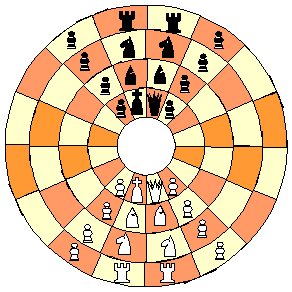 The pieces are set up back to back, facing outward, so that instead of one unified front, your pieces are funneled down two separate corridors, meeting up where they merge on the opposite side. The change in the setup of the board drastically alters gameplay, as most established Chess strategies no longer apply. Granted, the majority of the pieces retain their normal abilities, but the differed geometry of the field shifts the usual balance of power. No longer can the Bishop run the full length of the board, but only a maximum of three squares at a time. The Rook and Queen, however, find their power considerably boosted.
The pieces are set up back to back, facing outward, so that instead of one unified front, your pieces are funneled down two separate corridors, meeting up where they merge on the opposite side. The change in the setup of the board drastically alters gameplay, as most established Chess strategies no longer apply. Granted, the majority of the pieces retain their normal abilities, but the differed geometry of the field shifts the usual balance of power. No longer can the Bishop run the full length of the board, but only a maximum of three squares at a time. The Rook and Queen, however, find their power considerably boosted.
Consider: in basic Chess, an unobstructed Rook can effectively control two rows from it’s position, horizontally and vertically, equaling 1/8 of the board. In Circular Chess, with only four rows, that same Rook now controls over 1/4 of the board. A Knight can no longer “run free” in the middle, but is carefully maneuvering along the edge. And of course, you can’t move a piece completely around the board to end up in the same position it started the turn in.
There are few other mechanical differences between the original 10th century Chess variation and the modern version. As there are no “opposite edges” of the board, Pawns couldn’t ever be promoted, and if one ever ran into another pawn of the same color coming the other way, the opponent could remove both of them as a free move. Modern Circular Chess has adopted regular rules, so that if a Pawn advances six spaces, it is promoted as in normal Chess. Castling is no longer allowed, and neither are en passant captures, which is fortunate because I never really understood them.
This Variant is both easier and more challenging at the same time. Centuries of Chess theory get thrown out the window. The established opening and endgame strategies are largely meaningless. The importance and movement of pieces radically changes. You must consider not only where the piece you just moved is, but also how it is affected by pieces on the other side of the board. On the other hand, this alteration actually helps level the playing field between players of varying strength. As long as you know how the pieces normally move you can play this, and the landscape is so different that both players are almost at an equal disadvantage.
Circular Chess proves to be a wicked fun shake-up to the normal game, and I would definitely recommend a playthrough if you were to choose just one Variant to try..
Multiplayer
Think about when you get together with your family or your gaming group gets. When considering what to pull off the shelf, Chess rarely gets considered for the simple fact that it is a one-on-one game, and the only way to involve more people is to have several separate games going at once. Yippee…
As it turns out, there are alternatives. Over the years, players have come up with several Variants to include third and fourth players, making the competition a group effort, and upping the chances of Chess seeing play time.
Three Player Chess
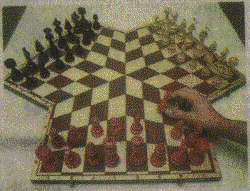 In standard Chess, players start opposite each other. In a three player game, the challenge is to design a board that allows any one player to start opposite the other two. This generally results in a hexagonal board.
In standard Chess, players start opposite each other. In a three player game, the challenge is to design a board that allows any one player to start opposite the other two. This generally results in a hexagonal board.
While many boards appear to have different profiles, if you study the actual cell layout (say, comparing the relationship between opposing Rooks) you will see that there is almost no actual difference between these three, six or nine-sided boards. As a general rule of thumb, if it has 96 cells, your pieces will be in a standard Chess opening position, and the only difference will really be in rule changes. Any truly different variations typically include a short corridor between starting positions and the middle of the board, or actual hexagonal grids requiring additional pieces usually extra Pawns and Bishops. With these, rather than a double row along a single side, pieces start arrayed along the two wings of a corner. Gameplay among the different Three Player variations remains largely consistent.
Like other Variants, the pieces retain their usual movement. The difficulty with the Three Player variations is clarity and balance. As in Circular Chess, the board is no longer a simple square grid pattern. Tracking the paths your pieces take requires paying close attention. The addition of a third player also introduces table politics. If two players focus their efforts on the third, he will most likely not have a chance.
Even ignoring the threat of vendetta, balance can be difficult to maintain. In standard Chess, it is pretty common to find yourself trading pieces with your opponent, sacrificing a weak or superfluous piece to gain an advantage. In a three player game, such a trade will leave the third player in the stronger position: she has lost no pieces in this exchange, while her opponents are both short one. The name of the game in multiplayer is caution. Let your opponents lose their pieces skirmishing with each other, and await an opportunity to swoop in through an unexpected angle for the kill.
Four Player Chess
 Surprisingly, four player games of Chess are simpler than their three player counterparts. Marketed today most commonly under the name Chess4, this Variant dates back to at least the 1770s. Rather than stretching the board to accommodate an odd number of players, the board is typically extended by three rows on each side. The first two rows are occupied by pieces in their regular starting positions, with a third empty row included to prevent Pawns on the end from capturing an opposing Pawn as a first move.
Surprisingly, four player games of Chess are simpler than their three player counterparts. Marketed today most commonly under the name Chess4, this Variant dates back to at least the 1770s. Rather than stretching the board to accommodate an odd number of players, the board is typically extended by three rows on each side. The first two rows are occupied by pieces in their regular starting positions, with a third empty row included to prevent Pawns on the end from capturing an opposing Pawn as a first move.
Gameplay is rather straightforward. Players may work together as teams, or engage in a free-for-all. Some balance problems of Three Player Chess are more easily avoided. Two players may have difficulty coordinating against the third if they have to worry about the fourth coming in to take advantage of the situation. Two players trading pieces benefits the other two, rather than leaving one player in a dominant position. The appeal of a four player game is that, besides being an ideal number for gaming purposes (four players being a pretty standard small group size), the game accommodates both aggressive and cautious players. The checks and balances of possible reprisals encourages even a strong Chess player to take a measured series of pushes and countermoves, rather than completely dominate the early game. While it still maintains its emphasis on intellectual challenge, the multiplayer environment makes it much more casual and relaxed.
Knightmare Chess
Although we’ve seen additional dimensions of strategy (literally) and radically changing the game board itself, through all of these developments Chess has remained a skill-based game, with luck being restricted to seeing a move your opponent didn’t. Enter Steve Jackson Games with an English translation of the French game “Storm on the Chessboard”, a set of 80 cards (with an additional 80 in the sequel) that, when played, alter the rules of the game. There are cards that allow you to move pieces simultaneously, exchange positions, demote an opponent’s piece to a Pawn, move their Bishop to capture one of their own pieces, build walls that obstruct movement, etc. If you think an element of chaos is needed to spice up your game, this is the Variant for you!
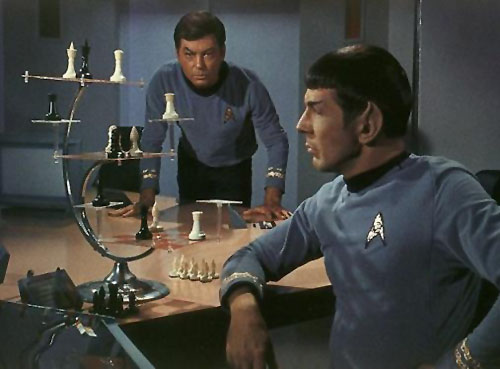
“I’m sorry, Doctor, but it appears that an interphasic chroniton spike has triggered a transdimensional reversion of your Queen-side Bishop.”
“Uh…What?”
This adds a badly needed element of unpredictability to many Chess matches. Yes, the pure contest between two minds can be stimulating, but often Chess simply isn’t fun enough to justify pulling out. Something like this will turn the experience right around. What I particularly enjoy about it is how well it integrates with other Chess Variants. Yes, it will spice up your Tri-Dimensional Chess match, but the very first time I tried Knightmare was while playing Chess4, and it left a better impression on us than most of the other board games played that night.
There are three types of Chess people: those who’ve never played, those who do, and those who have grown tired of it. What these Variants do is try to bridge the gaps between these divergent groups. Do you want to introduce someone to the game in a fun way? Have you given up because you can never win? Are you looking for a fresh challenge without learning a whole new system? Then consider one of these alternatives. Chess may be centuries old, but the game still has some surprises for you, if you know where to look.
![]()
Nathan Crocco is a regular contributor to the site. If you have particular game variants you wish to request of him, he can be reached at nathan@cardboardrepublic.com.
You can discuss this article over on our social media!
Photo Credits: James Bond by Carolus Chess; Tri-Dimensional Chess and 3D Chess sets by Chess.com; Tri-Dimensional overhead by Yestercade; Wooden Tri-Dimensional set by Big Willie Styles; Circular board and 3-player Chess by Chess Variants; Alternate 3-player Chess by Games From Everywhere; 4-player Chess set by Geek Alerts; Knightmare Chess cards by Rutracker; Spock by Gongumenn.


